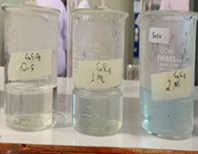Synthesis of Copper Nanoparticles with Dragon Fruit (Hylocereus polyrhizus) Extract as a Bio-Reductor and Their Analysis Using a UV-Visible Spectrophotometer
Abstract
Nanotechnology is a branch of science that investigates materials on a scale of 1-100 nanometers. One method that is often used to create copper nanoparticles is biosynthesis using plant extracts because it is more environmentally friendly, does not use toxic reagents and solvents and the process is simpler. Dragon fruit extract (Hylocereus polyrhizus) has potential as a reducing agent for metal compounds because it contains phenolic and carboxylic groups. This study aimed to synthesize copper nanoparticles (Cu-NPs) using a bio-reductor in the form of dragon fruit extract with various volume variations of CuSO4, pH variations, and stirring time variations. Red dragon fruit extraction was carried out by the maceration method to obtain extracts from dragon fruit, which were then used as a Cu metal-reducing agent. The resulting Cu nanoparticles were characterized using a UV-Visible Spectrophotometer. Based on the data, the highest absorbance value was obtained from the most volume of CuSO4, namely 2 mL with an absorbance peak at a wavelength of 700-750 nm. The optimum pH was obtained at pH 6 with a peak absorbance at a wavelength of 750 nm. The most effective time to obtain the absorbance peak at a wavelength of 700 nm was 15 min.
Downloads

Copyright (c) 2024 Ani Qomariyah, Ardhi Khoirul Hakim

This work is licensed under a Creative Commons Attribution-NonCommercial-NoDerivatives 4.0 International License.
Authors who publish with this journal agree to the following terms:
- Copyright on any article is retained by the author(s).
- The author grants the journal, the right of first publication with the work simultaneously licensed under a Creative Commons Attribution License that allows others to share the work with an acknowledgment of the work’s authorship and initial publication in this journal.
- Authors are able to enter into separate, additional contractual arrangements for the non-exclusive distribution of the journal’s published version of the work (e.g., post it to an institutional repository or publish it in a book), with an acknowledgment of its initial publication in this journal.
- Authors are permitted and encouraged to post their work online (e.g., in institutional repositories or on their website) prior to and during the submission process, as it can lead to productive exchanges, as well as earlier and greater citation of published work.
- The article and any associated published material is distributed under the Creative Commons Attribution-NonCommercial-NoDerivatives 4.0 International License.





_copy1.png)










